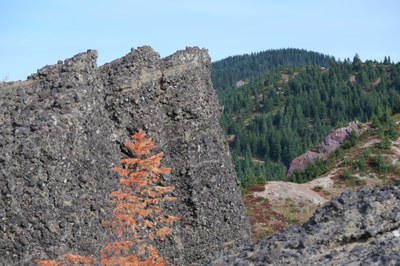
Trip Report
Basic Alpine Climb - Pinto Rock/Bowling Alley
A great route for those who are new to climbing to practice their climbing moves and multi-pitch transitions in a stunning environment.
- Sun, Sep 24, 2017
- Basic Alpine Climb - Pinto Rock/Bowling Alley
- Pinto Rock/Bowling Alley
- Climbing
- Successful
-

- Road rough but passable
-
NF-77 is in pretty rough shape. My AWD Subaru lost traction a few times. Be careful; I wouldn't bring a low clearance car on this road.
Our team of 4 students and 3 rope leads departed the trailhead toward Pinto Rock at around 7:15 AM on Sunday. We brought our full alpine-style packs to the base of the route, trying to get the students as much experience as possible as far as what to expect on an alpine climb. We reached the base of the climb in about 15 minutes, easily identifying the correct gully by the evergreen tree at its base. We dropped our full packs and donned our smaller summit packs and other climbing gear. This was a completely unnecessary step - my recommendation is to just take only what you plan to climb the entire route with from the car. The descent route takes you back to the cars, and then you have to go back up to the base to get your gear.
Routefinding was very easy. The route is so over bolted that it is hard to get lost. We tried to sling chicken heads to give the students a more alpine experience, but there was almost no opportunity to place nuts and cams. I placed one cam, one rope leader placed one nut, on the entire climb.
The climbing itself was enjoyable, four pitches of very low fifth class but still somewhat vertical in places, giving our new students the opportunity to get more climbing in than is typical of a basic climb. All anchor stations have new bolts and chains.
There is indeed loose rock in the bowling alley, justifying its name. We knocked down some microwave-sized chunks into a different gully at times, but luckily none of the rockfall went onto the climbing route itself.
Everyone chose their own footwear, which ranged from mountaineering boots to approach shoes to rock shoes. All worked fine.
The first group summited before 10 AM, about 2.5 hours after leaving the trailhead. After summit treats, we did one double rope rappel to descend, and got back to the base at around 12:30 PM. The base had several bolted sport routes that looked easy, so we had the opportunity to get one of the students his first ever sport lead (Congrats, Lance!), as we were waiting for the last rappellers. After the last rappel was done, we tried to pull the rope, but it was stuck as is typical of double rope rappels on routes that are famous for their chicken heads. A rope lead top roped up the route that had just been set and then led past the anchor chains to get the rope unstuck. It worked (Thanks, Nick!). It was still only 1 PM when our ropes were saved, which in my book is way too early to leave a beautiful rocky area with lots of sport routes, so we spent the next hour or so setting up top ropes for our students to practice more climbing on. This is the first (and probably only) time I've ever gotten to climb 7 pitches of rock on a basic climb. One of the sport routes had incredibly loose rock, however, so I would only do this with caution in the future. After kicking down some big ones we decided to call it a day, clean the top ropes, and head back to the cars. We were back to our cars by 2 PM, less than 7 hours after our departure.
No other parties were seen the entire day.
Gear needed: 4 quickdraws, 4 single runners, 4 double runners. Honestly, don't bother with metal pro unless you want to teach students how to make marginal gear placements.
I honestly think that this climb should be classified as a crag climb rather than an alpine rock climb. I awarded my students credit because 1) we had no idea about this leading up to the climb, 2) we tried our hardest to make the experience as alpine as possible, making sure they understood what to actually expect on a basic rock climb, and 3) we did get them more exposure to multi-pitch transitions and actual rock climbing than is typical on a basic climb.
 Sherrie Trecker
Sherrie Trecker